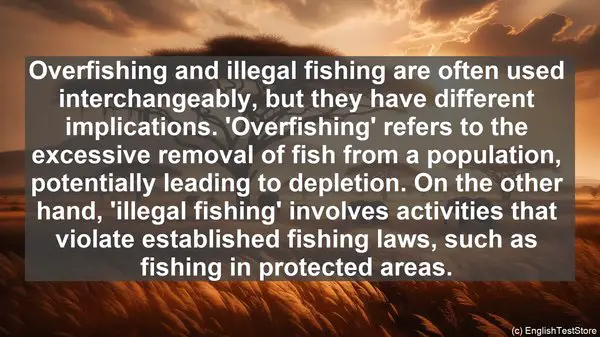Introduction
Welcome to today’s lesson on fishery management. As you delve deeper into this field, you’ll come across several terms that may seem similar but have distinct meanings. Today, we’ll explore the top 10 commonly confused words in fishery management.
1. Stock vs. Species
One of the fundamental distinctions is between ‘stock’ and ‘species.’ While ‘species’ refers to a group of organisms with shared characteristics, ‘stock’ specifically denotes a group of the same species in a particular area. Understanding the size and health of a stock is crucial for sustainable fishing.
2. Overfishing vs. Illegal Fishing
Overfishing and illegal fishing are often used interchangeably, but they have different implications. ‘Overfishing’ refers to the excessive removal of fish from a population, potentially leading to depletion. On the other hand, ‘illegal fishing’ involves activities that violate established fishing laws, such as fishing in protected areas.
3. Bycatch vs. Discards
Bycatch and discards both involve the unintentional capture of non-target species. However, ‘bycatch’ refers to the incidental catch that is retained, while ‘discards’ are the caught organisms that are thrown back into the water, often due to regulations or their low commercial value.
4. Marine Protected Areas vs. No-Take Zones
Marine Protected Areas (MPAs) and No-Take Zones (NTZs) are conservation tools, but their scope differs. MPAs encompass various zones with different levels of protection, while NTZs are specific areas where no fishing or extraction is allowed. Both play vital roles in preserving marine biodiversity.
5. Recruitment vs. Spawning
In fishery management, ‘recruitment’ and ‘spawning’ are distinct stages. ‘Spawning’ refers to the process of fish releasing eggs and sperm into the water, while ‘recruitment’ denotes the subsequent survival and addition of young fish to the population. Monitoring both is crucial for understanding population dynamics.
6. Maximum Sustainable Yield vs. Optimum Yield
Maximum Sustainable Yield (MSY) and Optimum Yield (OY) are management targets. MSY aims to achieve the highest catch level that can be sustained over the long term, while OY considers additional factors like economic and social aspects. Striking a balance between the two is a key challenge.
7. Biomass vs. Biodiversity
While ‘biomass’ refers to the total weight of living organisms in a given area, ‘biodiversity’ encompasses the variety of species, their genetic diversity, and the ecosystems they form. Both are essential indicators of ecosystem health and resilience.

8. Exclusive Economic Zone vs. Territorial Waters
Exclusive Economic Zones (EEZs) and Territorial Waters (TWs) are maritime zones with different jurisdictional rights. EEZs extend up to 200 nautical miles from a country’s coast and grant exclusive rights over resources, while TWs only stretch up to 12 nautical miles and are considered part of a country’s sovereign territory.

9. Aquaculture vs. Mariculture
Aquaculture and mariculture are both forms of fish farming. ‘Aquaculture’ is a broader term that encompasses the cultivation of aquatic organisms in various environments, including freshwater. ‘Mariculture’ specifically refers to the farming of marine organisms, such as fish, shellfish, or seaweed.
10. Tagging vs. Marking
Tagging and marking are methods used in fishery research. ‘Tagging’ involves attaching a physical tag, often with a unique identifier, to a fish. ‘Marking’ can be non-invasive, like using visible dyes, or involve internal markers, such as injecting a harmless chemical. Both aid in studying fish movement and population dynamics.
